Recent Advances in Biomass-Derived Carbon Materials for Sodium-Ion Energy Storage Devices
Abstract
:1. Introduction
2. Sodium-Ion Storage Mechanism in Carbonaceous Materials for SESDs
2.1. Configuration and Mechanism of Sodium-Ion Batteries
2.2. Configuration and Mechanism of Sodium-Ion Capacitors
3. Diverse Morphology of Biomass-Derived Carbons for SESDs
3.1. Tubular and Fiber-Shaped Biomass-Derived Carbons
3.2. Sheet-Shaped, Biomass-Derived Carbons
3.3. 3D Hierarchical Structures of Biomass-Derived Carbon
4. Different Structures and Components of Biomass-Derived Carbons for SESDs
4.1. Degree of Graphitization
4.2. Heteroatom Doping
4.3. Hybridization of Biomass-Derived Carbon and Metal Compounds
5. Conclusions, Challenges, and Outlook
Author Contributions
Funding
Data Availability Statement
Acknowledgments
Conflicts of Interest
References
- Chen, S.; Chao, W.; Shen, L.; Zhu, C.; Huang, Y.; Kai, X.; Maier, J.; Yan, Y. Challenges and Perspectives for NASICON-Type Electrode Materials for Advanced Sodium-Ion Batteries. Adv. Mater. 2017, 29, 1700431. [Google Scholar] [CrossRef] [PubMed]
- Peng, Z.; Qin, F.; Lei, Z.; Wang, M.; Kai, Z.; Lai, Y.; Jie, L. Few-layered MoS2/C with expanding d-spacing as a high-performance anode for sodium-ion batteries. Nanoscale 2017, 9, 12189–12195. [Google Scholar]
- Palomares, V.; Serras, P.; Villaluenga, I.; Hueso, K.B.; Carretero-González, J.; Rojo, T. Na-ion batteries, recent advances and present challenges to become low cost energy storage systems. Energy Environ. Sci. 2012, 5, 5884–5901. [Google Scholar] [CrossRef]
- Ge, P.; Zhang, C.; Hou, H.; Wu, B.; Zhou, L.; Li, S.; Wu, T.; Hu, J.; Mai, L.; Ji, X. Anions induced evolution of Co3X4 (X=O, S, Se) as sodium-ion anodes: The influences of electronic structure, morphology, electrochemical property. Nano Energy 2018, 48, 617–629. [Google Scholar] [CrossRef]
- Yu, P.; Zhang, W.; Yang, Y.; Zheng, M.; Hu, H.; Xiao, Y.; Liu, Y.; Liang, Y. Facile construction of uniform ultramicropores in porous carbon for advanced sodium-ion battery. J. Colloid Interface Sci. 2021, 582, 852–858. [Google Scholar] [CrossRef]
- Wang, L.; Wei, Z.; Mao, M.; Wang, H.; Li, Y.; Ma, J. Metal Oxide/Graphene Composite Anode Materials for Sodium-Ion Batteries. Energy Storage Mater. 2018, 16, 434–454. [Google Scholar] [CrossRef]
- Cao, X.; Pan, A.; Yin, B.; Fang, G.; Wang, Y.; Kong, X.; Zhu, T.; Zhou, J.; Cao, G.; Liang, S. Nanoflake-constructed porous Na3V2(PO4)3/C hierarchical microspheres as a bicontinuous cathode for sodium-ion batteries applications. Nano Energy 2019, 60, 312–323. [Google Scholar] [CrossRef]
- Chen, J.; Fan, X.; Ji, X.; Gao, T.; Hou, S.; Zhou, X.; Wang, L.; Wang, F.; Yang, C.; Chen, L. Intercalation of Bi nanoparticles into graphite results in an ultra-fast and ultra-stable anode material for sodium-ion batteries. Energy Environ. Sci. 2018, 11, 1218–1225. [Google Scholar] [CrossRef]
- Wang, Q.; Zhao, C.; Lu, Y.; Li, Y.; Zheng, Y.; Qi, Y.; Rong, X.; Jiang, L.; Qi, X.; Shao, Y.; et al. Advanced Nanostructured Anode Materials for Sodium-Ion Batteries. Small 2017, 13, 1701835. [Google Scholar] [CrossRef]
- Wei, C.; Liang, H.; Qi, Z.; Shao, L.; Wang, Z. Enhanced electrochemical properties of lithium cobalt titanate via lithium-site substitution with sodium. Electrochim. Acta 2015, 174, 1202–1215. [Google Scholar]
- Luo, J.Y.; Wang, Y.G.; Xiong, H.M.; Xia, Y.Y. Ordered Mesoporous Spinel LiMn2O4 by a Soft-Chemical Process as a Cathode Material for Lithium-Ion Batteries. J. Cheminfom. 2007, 38, 4791–4795. [Google Scholar]
- Padhi, A.K. Phospho-olivines as Positive-Electrode Materials for Rechargeable Lithium Batteries. J. Electrochem. Soc. 1997, 144, 1188–1194. [Google Scholar] [CrossRef]
- Xiang, X.; Zhang, K.; Chen, J. Recent Advances and Prospects of Cathode Materials for Sodium-Ion Batteries. Adv. Mater. 2015, 27, 5343–5364. [Google Scholar] [CrossRef]
- Liu, H.; He, B.; Xiang, W.; Li, Y.C.; Guo, X. Synergistic effect of uniform lattice cation/anion doping improved structural and electrochemical performance stability for Li-rich cathode materials. Nanotechnology 2020, 31, 455704. [Google Scholar] [CrossRef]
- Gezovi, A.; Vujkovi, M.J.; Milovi, M.; Grudi, V.; Mentus, S. Recent developments of Na4M3(PO4)2(P2O7) as the cathode material for alkaline-ion rechargeable batteries: Challenges and outlook. Energy Storage Mater. 2021, 37, 243–273. [Google Scholar] [CrossRef]
- Xian, L.; Li, M.; Qiu, D.; Qiu, C.; Yue, C.; Wang, F.; Yang, R. P3-type layered Na0. 26Co1-xMnxO2 cathode induced by Mn doping for high-performance sodium-ion batteries. J. Alloys Compd. 2022, 905, 163965. [Google Scholar] [CrossRef]
- Peters, J.; Buchholz, D.; Passerini, S.; Weil, M. Life cycle assessment of sodium-ion batteries. Energy Environ. Sci. 2016, 9, 1744–1751. [Google Scholar] [CrossRef] [Green Version]
- Zhang, J.; Chen, Z.; Wang, G.; Hou, L.; Yuan, C. Eco-friendly and scalable synthesis of micro-/mesoporous carbon sub-microspheres as competitive electrodes for supercapacitors and sodium-ion batteries. Appl. Surf. Sci. 2020, 533, 147511. [Google Scholar] [CrossRef]
- Thomas, P.; Billaud, D. Electrochemical insertion of sodium into hard carbons. Electrochim. Acta 2003, 47, 3303–3307. [Google Scholar] [CrossRef]
- Divincenzo, D.P.; Mele, E.J. Cohesion and structure in stage-1 graphite intercalation compounds. Phys. Rev. B 1985, 32, 2538–2553. [Google Scholar] [CrossRef]
- Zhou, X.; Guo, Y.G. Highly Disordered Carbon as a Superior Anode Material for Room-Temperature Sodium-Ion Batteries. ChemElectroChem 2014, 1, 83–86. [Google Scholar] [CrossRef]
- Xiao, L.; Cao, Y.; Henderson, W.A.; Sushko, M.L.; Shao, Y.; Xiao, J.; Wang, W.; Engelhard, M.H.; Nie, Z.; Liu, J. Hard carbon nanoparticles as high-capacity, high-stability anodic materials for Na-ion batteries. Nano Energy 2016, 19, 279–288. [Google Scholar] [CrossRef] [Green Version]
- Bo, H.; Kan, W.; Liheng, W.; Shu-Hong, Y.; Markus, A.; Maria-Magdalena, T. Engineering carbon materials from the hydrothermal carbonization process of biomass. Adv. Mater. 2020, 22, 813–828. [Google Scholar]
- Lu, H.; Ai, F.; Jia, Y.; Tang, C.; Zhang, X.; Huang, Y.; Yang, H.; Cao, Y. Exploring Sodium-Ion Storage Mechanism in Hard Carbons with Different Microstructure Prepared by Ball-Milling Method. Small 2018, 14, 1802694. [Google Scholar] [CrossRef]
- Wu, Z.Y.; Ma, C.; Bai, Y.L.; Liu, Y.S.; Wang, S.; Wei, X.; Wang, K.X.; Chen, J.S. Rubber-Based Carbon Electrode Materials Derived from Dumped Tires for Efficient Sodium-ion Storage. Dalton Trans. 2018, 47, 4885–4892. [Google Scholar] [CrossRef]
- Xiao, L.; Lu, H.; Fang, Y.; Sushko, M.L.; Cao, Y.; Ai, X.; Yang, H.; Liu, J. Low-Defect and Low-Porosity Hard Carbon with High Coulombic Efficiency and High Capacity for Practical Sodium Ion Battery Anode. Adv. Eng. Mater. 2018, 8, 1703238. [Google Scholar] [CrossRef]
- Mohan, E.H.; Anandan, S.; Appa Rao, B.V. Neem Leaf-derived Micro and Mesoporous Carbon as an Efficient Polysulfide Inhibitor for Sulfur Cathode in a Li-S Battery. Chem. Lett. 2019, 48, 62–64. [Google Scholar] [CrossRef]
- Izanzar, I.; Dahbi, M.; Kiso, M.; Doubaji, S.; Komaba, S.; Saadoune, I. Hard carbons issued from date palm as efficient anode materials for sodium-ion batteries. Carbon 2018, 137, 165–173. [Google Scholar] [CrossRef]
- Wang, H.; Yu, W.; Jing, S.; Mao, N.; Chen, S.; Wei, L. Biomass derived hierarchical porous carbons as high-performance anodes for sodium-ion batteries. Electrochim. Acta 2016, 188, 103–110. [Google Scholar] [CrossRef]
- Deng, J.; Li, M.; Wang, Y. Biomass-derived carbon: Synthesis and applications in energy storage and conversion. Green Chem. 2016, 18, 4824–4854. [Google Scholar] [CrossRef]
- Yin, Y.; Yan, S.; Ni, Z.; Jin, C.; Zhao, L. Economical synthesized Mn3O4/biomass-derived carbon from vegetable sponge composites and its excellent supercapacitive behavior. Biomass Convers. Biorefin. 2021, 1–10. [Google Scholar] [CrossRef]
- Chen, K.; Li, G.; Wang, Y.; Chen, W.; Mi, L. High loading FeS2 nanoparticles anchored on biomass-derived carbon tube as low cost and long cycle anode for sodium-ion batteries. Green Energy Environ. 2020, 5, 50–58. [Google Scholar] [CrossRef]
- Liu, N.; Wang, Y.; Zhang, X.; He, E.; Zhang, Z.; Yu, L. Litchi-like porous carbon nanospheres prepared from crosslinked polymer precursors for supercapacitors and electromagnetic wave absorption. Chem. Eng. J. 2021, 416, 128926. [Google Scholar] [CrossRef]
- Yang, M.; Dai, J.; He, M.; Duan, T.; Yao, W. Biomass-derived carbon from Ganoderma lucidum spore as a promising anode material for rapid potassium-ion storage. J. Colloid Interface Sci. 2020, 567, 256–263. [Google Scholar] [CrossRef]
- Yu, Z.; Zhao, Z.; Peng, T. Coralloid carbon material based on biomass as a promising anode material for lithium and sodium storage. New J. Chem. 2021, 45, 7138–7144. [Google Scholar] [CrossRef]
- Yang, W.; Kai, H.; Zhu, Y.; Han, F.; Wang, C. Expanded graphite as superior anode for sodium-ion batteries. Nat. Commun. 2014, 5, 4033. [Google Scholar]
- Zahra, H.; Sawada, D.; Guizani, C.; Ma, Y.; Kumagai, S.; Yoshioka, T.; Hummel, M. Close packing of cellulose and chitosan in regenerated cellulose fibers improves carbon yield and structural properties of respective carbon fibers. Biomacromolecules 2020, 21, 4326–4335. [Google Scholar] [CrossRef]
- Sun, Y.; Lu, P.; Liang, X.; Chen, C.; Xiang, H. High-yield microstructure-controlled amorphous carbon anode materials through a pre-oxidation strategy for sodium ion batteries. J. Alloys Compd. 2019, 786, 468–474. [Google Scholar] [CrossRef]
- Hassan, M.M.; Schiermeister, L.; Staiger, M.P. Sustainable production of carbon fiber: Effect of cross-linking in wool fiber on carbon yields and morphologies of derived carbon fiber. ACS Sustain. Chem. Eng. 2015, 3, 2660–2668. [Google Scholar] [CrossRef] [Green Version]
- Yu, F.; Liu, Z.; Zhou, R.; Tan, D.; Wang, H.; Wang, F. Pseudocapacitance contribution in boron-doped graphite sheets for anion storage enables high-performance sodium-ion capacitors. Mater. Horiz. 2018, 5, 529–535. [Google Scholar] [CrossRef]
- Zhu, Y.; Chen, M.; Li, Q.; Yuan, C.; Wang, C. High-yield humic acid-based hard carbons as promising anode materials for sodium-ion batteries. Carbon 2017, 123, 727–734. [Google Scholar] [CrossRef]
- Li, P.; Jeong, J.Y.; Jin, B.; Zhang, K.; Park, J.H. Vertically oriented MoS2 with spatially controlled geometry on nitrogenous graphene sheets for high-performance sodium-ion batteries. Adv. Energy Mater. 2018, 8, 1703300. [Google Scholar] [CrossRef]
- Wang, J.; Cui, Y.; Gu, Y.; Xu, H.; Zhuang, Q. Coal-Based modified Carbon for High Performance Sodium-Ion Battery. Solid State Ion. 2021, 368, 115701. [Google Scholar] [CrossRef]
- Xu, X.; Zeng, H.; Han, D.; Qiao, K.; Xing, W.; Rood, M.J.; Yan, Z. Nitrogen and sulfur co-doped graphene nanosheets to improve anode materials for sodium-ion batteries. ACS Appl. Mater. Interfaces 2018, 10, 37172–37180. [Google Scholar] [CrossRef]
- Niu, Q.; Tang, Q.; Sun, X.; Wang, L.; Gao, K. Wood-based carbon tubes with low-tortuosity and open tubular structure for energy storage application. J. Mater. Sci. 2022, 57, 5154–5166. [Google Scholar] [CrossRef]
- Li, Y.; Hu, Y.S.; Titirici, M.M.; Chen, L.; Huang, X. Hard Carbon Microtubes Made from Renewable Cotton as High-Performance Anode Material for Sodium-Ion Batteries. Adv. Energy Mater. 2016, 6, 1600659. [Google Scholar] [CrossRef]
- Yu, Z.E.; Lyu, Y.; Wang, Y.; Xu, S.; Cheng, H.; Mu, X.; Guo, B. Hard carbon micro-nano tubes derived from kapok fiber as anode materials for sodium-ion batteries and the sodium-ion storage mechanism. Chem. Commun. 2020, 56, 778–781. [Google Scholar] [CrossRef]
- Chen, C.; Huang, Y.; Meng, Z.; Xu, Z.; Liu, P.; Li, T. Multi-heteroatom doped porous carbon derived from insect feces for capacitance-enhanced sodium-ion storage. J. Energy Chem. 2021, 54, 482–492. [Google Scholar] [CrossRef]
- Wang, B.; Wang, Y.; Peng, Y.; Wang, X.; Wang, N.; Wang, J.; Zhao, J. Nitrogen-doped biomass-based hierarchical porous carbon with large mesoporous volume for application in energy storage. Chem. Eng. J. 2018, 348, 850–859. [Google Scholar] [CrossRef]
- Gao, X.; Yu, Y.; He, Q.; Li, H.; Liu, Y. Transition metal assisted ionothermal carbonization of cellulose towards high yield and recycling. Cellulose 2021, 28, 4025–4037. [Google Scholar] [CrossRef]
- Li, C.; Li, J.; Zhang, Y.; Cui, X.; Lei, H.; Li, G. Heteroatom-doped hierarchically porous carbons derived from cucumber stem as high-performance anodes for sodium-ion batteries. J. Mater. Chem. 2018, 54, 5641–5657. [Google Scholar] [CrossRef]
- Lang, J.; Li, J.; Zhang, F.; Ding, X.; Zapien, J.A.; Tang, Y. Sodium-Ion Hybrid Battery Combining an Anion-Intercalation Cathode with an Adsorption-Type Anode for Enhanced Rate and Cycling Performance. Batter. Supercaps 2019, 2, 440–447. [Google Scholar] [CrossRef]
- Li, J.; Wang, L.; Li, L.; Lv, C.; Zatovsky, I.V.; Han, W. Metal sulfides@ carbon microfiber networks for boosting lithium ion/sodium ion storage via a general metal–aspergillus niger bioleaching strategy. ACS Appl. Mater. Interfaces 2019, 11, 8072–8080. [Google Scholar] [CrossRef]
- Li, D.; Sun, Y.; Chen, S.; Yao, J.; Zhang, Y.; Xia, Y.; Yang, D. Highly Porous FeS/Carbon Fibers Derived from Fe-Carrageenan Biomass: High-capacity and Durable Anodes for Sodium-Ion Batteries. ACS Appl. Energy Mater. 2018, 10, 17175–17182. [Google Scholar] [CrossRef]
- Zhang, J.; Lv, W.; Zheng, D.; Liang, Q.; Wang, D.W.; Kang, F.; Yang, Q.H. The interplay of oxygen functional groups and folded texture in densified graphene electrodes for compact sodium-ion capacitors. Adv. Energy Mater. 2018, 8, 1702395. [Google Scholar] [CrossRef]
- Dan, R.; Chen, W.; Xiao, Z.; Li, P.; Liu, M.; Chen, Z.; Yu, F. N-Doped Biomass Carbon/Reduced Graphene Oxide as a High-Performance Anode for Sodium-Ion Batteries. Energy Fuels 2020, 34, 3923–3930. [Google Scholar] [CrossRef]
- Ge, P.; Fouletier, M. Electrochemical intercalation of sodium in graphite—ScienceDirect. Solid State Ionics 1988, 28, 1172–1175. [Google Scholar] [CrossRef]
- Lau, W.H.; Kim, J.B.; Zou, F.; Kang, Y.M. Elucidating the charge storage mechanism of carbonaceous and organic electrode materials for sodium ion batteries. Chem. Commun. 2021, 57, 13465–13494. [Google Scholar] [CrossRef] [PubMed]
- Lu, Y.; Shin, K.H.; Yu, Y.; Hu, Y.; Liang, J.; Chen, K.; Yuan, H.; Park, H.S.; Wang, D. Multiple Active Sites Carbonaceous Anodes for Na+ Storage: Synthesis, Electrochemical Properties and Reaction Mechanism Analysis. Adv. Funct. Mater. 2021, 31, 2007247. [Google Scholar] [CrossRef]
- Hu, Y.; Zhang, L.; Bai, J.; Liu, F.; Wang, Z.; Wu, W.; Bradley, R.; Li, L.; Ruan, H.; Guo, S. Boosting High-Rate Sodium Storage of CuS via a Hollow Spherical Nanostructure and Surface Pseudocapacitive Behavior. ACS Appl. Energy Mater. 2021, 4, 8901–8909. [Google Scholar] [CrossRef]
- Song, K.; Liu, C.; Mi, L.; Chou, S.; Chen, W.; Shen, C. Recent progress on the alloy-based anode for sodium-ion batteries and potassium-ion batteries. Small 2021, 17, 1903194. [Google Scholar] [CrossRef]
- Cao, Y.; Zhang, Q.; Wei, Y.; Guo, Y.; Cui, Y. A Water Stable, Near-Zero-Strain O3-Layered Titanium-Based Anode for Long Cycle Sodium-Ion Battery. Adv. Funct. Mater. 2019, 30, 1907023. [Google Scholar] [CrossRef]
- Nobuhara, K.; Nakayama, H.; Nose, M.; Nakanishi, S.; Iba, H. First-principles study of alkali metal-graphite intercalation compounds. J. Power Sources 2013, 243, 585–587. [Google Scholar] [CrossRef]
- Zhu, Z.; Cheng, F.; Zhe, H.; Niu, Z.; Chen, J. Highly stable and ultrafast electrode reaction of graphite for sodium ion batteries. J. Power Sources 2015, 293, 626–634. [Google Scholar] [CrossRef]
- Wan, J.; Shen, F.; Luo, W.; Zhou, L.; Dai, J.; Han, X.; Bao, W.; Xu, Y.; Panagiotopoulos, J.; Fan, X.; et al. In Situ Transmission Electron Microscopy Observation of Sodiation–Desodiation in a Long Cycle, High-Capacity Reduced Graphene Oxide Sodium-Ion Battery Anode. Chem. Mater. 2016, 28, 6528. [Google Scholar] [CrossRef]
- Luo, X.F.; Yang, C.H.; Peng, Y.Y.; Pu, N.W.; Ger, M.D.; Hsiehd, C.T.; Chang, J.K. Graphene nanosheets, carbon nanotubes, graphite, and activated carbon as anode materials for sodium-ion batteries. J. Mater. Chem. A 2015, 3, 10320. [Google Scholar] [CrossRef]
- Jian, Z.; Bommier, C.; Luo, L.; Li, Z.; Wang, W.; Wang, C.; Greaney, P.A.; Ji, X. Insights on the Mechanism of Na-Ion Storage in Soft Carbon Anode. Chem. Mater. 2017, 29, 2314–2320. [Google Scholar] [CrossRef]
- Gomez-Martin, A.; Martinez-Fernandez, J.; Ruttert, M.; Winter, M.; Placke, T.; Ramirez-Rico, J. Correlation of Structure and Performance of Hard Carbons as Anodes for Sodium Ion Batteries. Chem. Mater. 2019, 31, 7288–7299. [Google Scholar] [CrossRef]
- Cao, Y.; Xiao, L.; Sushko, M.L.; Wang, W.; Schwenzer, B.; Xiao, J.; Nie, Z.; Saraf, L.V.; Yang, Z.; Liu, J. Sodium ion insertion in hollow carbon nanowires for battery applications. Nano Lett. 2012, 12, 3783–3787. [Google Scholar] [CrossRef]
- Yang, B.; Chen, J.; Lei, S.; Guo, R.; Li, H.; Shi, S.; Yan, X. Spontaneous Growth of 3D Framework Carbon from Sodium Citrate for High Energy-and Power-Density and Long-Life Sodium-Ion Hybrid Capacitors. Adv. Energy Mater. 2018, 8, 1702409. [Google Scholar] [CrossRef]
- Chen, D.; Zhang, W.; Luo, K.; Song, Y.; Guo, X. Hard carbon for sodium storage: Mechanism and optimization strategies toward commercialization. Energy Environ. Sci. 2021, 14, 2244–2262. [Google Scholar] [CrossRef]
- Stevens, D.A.; Dahn, J.R. High capacity anode materials for rechargeable sodium-ion batteries. J. Electrochem. Soc. 2000, 147, 1271–1273. [Google Scholar] [CrossRef]
- Wang, X.; He, S.; Chen, F.; Hou, X. Nitrogen-Doped Hard Carbon as Symmetric Electrodes for Sodium-Ion Capacitor. Energy Fuels 2020, 34, 13144–13148. [Google Scholar] [CrossRef]
- Subburam, G.; Ramachandran, K.; El-Khodary, S.A.; Zou, B.; Lian, J. Development of Porous Carbon Nanosheets from Polyvinyl Alcohol for Sodium-Ion Capacitors. Chem. Eng. J. 2021, 415, 129012. [Google Scholar] [CrossRef]
- Kuratani, K.; Yao, M.; Senoh, H.; Takeichi, N.; Sakai, T.; Kiyobayashi, T. Kiyobayashi Na-ion capacitor using sodium pre-doped hard carbon and activated carbon. Electrochim. Acta 2012, 76, 32. [Google Scholar] [CrossRef]
- Li, W.; Huang, J.; Feng, L. Controlled synthesis of macroscopic three-dimensional hollow reticulate hard carbon as long-life anode materials for Na-ion batteries. J. Alloys Compd. 2017, 716, 210–219. [Google Scholar] [CrossRef]
- Zhang, L.; Zhao, W.; Jiang, F. Carbon nanosheets from biomass waste: Insights into the role of a controlled pore structure for energy storage. Sustain. Energy Fuels 2020, 4, 3552–3565. [Google Scholar] [CrossRef]
- Qing, L.; Li, R.; Su, W.; Zhao, W.; Li, Y.; Chen, G.; Chen, J. Nanostructures of Carbon Nanofiber-Constrained Stannous Sulfide with High Flexibility and Enhanced Performance for Sodium-Ion Batteries. Energy Fuels 2022, 36, 2179–2188. [Google Scholar] [CrossRef]
- Liu, H.; Liu, H.; Di, S.; Zhai, B.; Li, L.; Wang, S. Advantageous Tubular Structure of Biomass-Derived Carbon for High-Performance Sodium Storage. ACS Appl. Energy Mater. 2021, 4, 4955–4965. [Google Scholar] [CrossRef]
- Xu, S.-D.; Zhao, Y.; Liu, S.; Ren, X.; Chen, L.; Shi, W.; Wang, X.; Zhang, D. Curly hard carbon derived from pistachio shells as high-performance anode materials for sodium-ion batteries. J. Mater. Chem. 2018, 53, 12334–12351. [Google Scholar] [CrossRef]
- Zhu, Z.; Liang, F.; Zhou, Z.; Zeng, X.; Wang, D.; Dong, P.; Zhao, J.; Sun, S.; Zhang, Y.; Li, X. Expanded biomass-derived hard carbon with ultra-stable performance in sodium-ion batteries. J. Mater. Chem. 2018, 6, 1513–1522. [Google Scholar] [CrossRef]
- Li, X.; Zeng, X.; Ren, T.; Zhao, J.; Zhu, Z.; Sun, S.; Zhang, Y. The transport properties of sodium-ion in the low potential platform region of oatmeal-derived hard carbon for sodium-ion batteries. J. Alloys Compd. 2019, 787, 229–238. [Google Scholar] [CrossRef]
- Jin, Q.; Li, W.; Wang, K.; Li, H.; Feng, P.; Zhang, Z.; Jiang, K. Tailoring 2D heteroatom-doped carbon nanosheets with dominated pseudocapacitive behaviors enabling fast and high-performance sodium storage. Adv. Funct. Mater. 2020, 30, 1909907. [Google Scholar] [CrossRef]
- Wang, Y.; Feng, Z.; Zhu, W.; Gariepy, V.; Gagnon, C.; Provencher, M.; Laul, D.; Veillette, R.; Trudeau, M.L.; Guerfi, A.; et al. High Capacity and High Efficiency Maple Tree-Biomass-Derived Hard Carbon as an Anode Material for Sodium-Ion Batteries. Materials 2018, 11, 1294. [Google Scholar] [CrossRef] [Green Version]
- Zhang, Y.; Wang, P.; Yin, Y. Carbon coated amorphous bimetallic sulfide hollow nanocubes towards advanced sodium ion battery anode. Carbon 2019, 150, 378–387. [Google Scholar] [CrossRef]
- Yan, Z.; Yang, Q.W.; Wang, Q. Nitrogen doped porous carbon as excellent dual anodes for Li-and Na-ion batteries. Chin. Chem. Lett. 2020, 31, 583–588. [Google Scholar] [CrossRef]
- Xue, X.; Weng, Y.; Jiang, Z.; Yang, S.; Wu, Y.; Meng, S.; Zhang, Y. Naturally nitrogen-doped porous carbon derived from waste crab shell as anode material for high performance sodium-ion battery. J. Anal. Appl. Pyrolysis 2021, 157, 105215. [Google Scholar] [CrossRef]
- Luo, D.; Han, P.; Shi, L.; Huang, J.; Yu, J.; Lin, Y.; Du, J.; Yang, B.; Li, C.; Zhu, C.; et al. Biomass-derived nitrogen/oxygen co-doped hierarchical porous carbon with a large specific surface area for ultrafast and long-life sodium-ion batteries. Appl. Surf. Sci. 2018, 462, 713–719. [Google Scholar] [CrossRef]
- Zhang, Y.; Li, X.; Dong, P.; Wu, G.; Xiao, J.; Zeng, X.; Zhang, Y.; Sun, X. Honeycomb-like Hard Carbon Derived from Pine Pollen as High-Performance Anode Material for Sodium-Ion Batteries. ACS Appl. Mater. Interfaces 2018, 10, 42796–42803. [Google Scholar] [CrossRef]
- Qin, D.; Chen, S. A sustainable synthesis of biomass carbon sheets as excellent performance sodium ion batteries anode. J. Solid State Electrochem. 2017, 21, 1305–1312. [Google Scholar] [CrossRef]
- Zhu, Y.; Huang, Y.; Chen, C.; Wang, M.; Liu, P. Phosphorus-doped porous biomass carbon with ultra-stable performance in sodium storage and lithium storage. Electrochim. Acta 2019, 321, 134698. [Google Scholar] [CrossRef]
- Zhang, J.; Zhang, D.; Li, K.; Tian, Y.; Wang, Y.; Sun, T. N, O and S co-doped hierarchical porous carbon derived from a series of samara for lithium and sodium storage: Insights into surface capacitance and inner diffusion. J. Colloid Interface Sci. 2021, 598, 250–259. [Google Scholar] [CrossRef]
- Cao, L.; Hui, W.; Xu, Z.; Huang, J.; Zheng, P.; Li, J.; Sun, Q. Rape seed shuck derived-lamellar hard carbon as anodes for sodium-ion batteries. J. Alloys Compd. 2017, 695, 632–637. [Google Scholar] [CrossRef]
- Beda, A.; Villevieille, C.; Taberna, P.L.; Simon, P.; Ghimbeu, C.M. Self-Supported Binder-Free Hard Carbon Electrodes for Sodium-Ion Batteries: Insights into the Sodium Storage Mechanisms. J. Mater. Chem. A 2020, 8, 5558–5571. [Google Scholar] [CrossRef]
- Guan, L.; Pan, L.; Peng, T.; Gao, C.; Zhao, W.; Yang, Z.; Hu, H.; Wu, M. Synthesis of Biomass-Derived Nitrogen-Doped Porous Carbon Nanosheests for High-Performance Supercapacitors. ACS Sustain. Chem. Eng. 2019, 7, 8405–8412. [Google Scholar] [CrossRef]
- Wang, P.; Li, X.; Li, X.; Shan, H.; Li, D.; Sun, X. Paulownia tomentosa derived porous carbon with enhanced sodium storage. J. Mater. Res. 2018, 33, 1236–1246. [Google Scholar] [CrossRef]
- Ou, J.; Yang, L.; Xi, X. Nitrogen-rich porous carbon anode with high performance for sodium ion batteries. J. Porous Mater. 2016, 24, 189–192. [Google Scholar] [CrossRef]
- Xu, J.; Wang, M.; Wickramaratne, N.P.; Jaroniec, M.; Dou, S.; Dai, L. High-performance sodium ion batteries based on a 3D anode from nitrogen-doped graphene foams. Adv. Mater. 2015, 27, 2042–2048. [Google Scholar] [CrossRef]
- Wang, C.; Huang, J.; Li, Q. Catalyzing carbon surface by Ni to improve initial coulombic efficiency of sodium-ion batteries. J. Energy Storage 2020, 32, 101868. [Google Scholar] [CrossRef]
- Yu, Y.; Ren, Z.; Li, L. Ionic liquid-induced graphitization of biochar: N/P dual-doped carbon nanosheets for high-performance lithium/sodium storage. J. Mater. Sci. 2021, 56, 8186–8201. [Google Scholar] [CrossRef]
- Wu, F.; Zhang, M.; Bai, Y.; Wang, X.; Dong, R.; Wu, C. Lotus seedpod-derived hard carbon with hierarchical porous structure as stable anode for sodium-ion batteries. ACS Appl Mater. Interfaces 2019, 11, 12554–12561. [Google Scholar] [CrossRef] [PubMed]
- Susanti, R.F.; Alvin, S.; Kim, J. Toward high-performance hard carbon as an anode for sodium-ion batteries: Demineralization of biomass as a critical step. J. Ind. Eng. Chem. 2020, 91, 317–329. [Google Scholar] [CrossRef]
- Hou, H.; Yu, C.; Liu, X.; Yao, Y.; Dai, Z.; Li, D. The effect of carbonization temperature of waste cigarette butts on Na-storage capacity of N-doped hard carbon anode. Chem. Pap. 2019, 73, 1237–1246. [Google Scholar] [CrossRef]
- Li, T.; Liu, Z.; Gu, Y. Hierarchically porous hard carbon with graphite nanocrystals for high-rate sodium ion batteries with improved initial Coulombic efficiency. J. Alloys Compd. 2020, 817, 152703. [Google Scholar] [CrossRef]
- Alvin, S.; Yoon, D.; Chandra, C.; Susanti, R.F.; Chang, W.; Ryu, C.; Kim, J. Extended flat voltage profile of hard carbon synthesized using a two-step carbonization approach as an anode in sodium ion batteries. J. Power Sources 2019, 430, 157–168. [Google Scholar] [CrossRef]
- Ou, J.; Yang, L.; Xi, X. Hierarchical porous nitrogen doped carbon derived from horn comb as anode for sodium-ion storage with high performance. Electron. Mater. Lett. 2017, 13, 66–71. [Google Scholar] [CrossRef]
- Zhao, X.; Ding, Y.; Xu, Q.; Yu, X.; Liu, Y.; Shen, H. Low-Temperature Growth of Hard Carbon with Graphite Crystal for Sodium-Ion Storage with High Initial Coulombic Efficiency: A General Method. Adv. Energy Mater. 2019, 9, 1803648. [Google Scholar] [CrossRef]
- Tang, Z.; Wang, Y.; Zheng, Z.; Luo, X. In situ dual growth of graphitic structures in biomass carbon to yield a potassium-ion battery anode with high initial coulombic efficiency. J. Mater. Chem. A 2021, 9, 9191–9202. [Google Scholar] [CrossRef]
- Chen, C.; Huang, Y.; Zhu, Y.; Zhang, Z.; Guang, Z.; Meng, Z.; Liu, P. Nonignorable Influence of Oxygen in Hard Carbon for Sodium Ion Storage. ACS Sustain. Chem. Eng. 2020, 8, 1497–1506. [Google Scholar] [CrossRef]
- Liu, X.; Wang, H.; Cui, Y.; Xu, X.; Zhang, H.; Lu, G.; Shi, J.; Liu, W.; Chen, S.; Wang, X. High-energy sodium-ion capacitor assembled by hierarchical porous carbon electrodes derived from Enteromorpha. J. Mater. Sci. 2018, 53, 6763–6773. [Google Scholar] [CrossRef]
- Khan, M.; Ahmad, N.; Lu, K. Nitrogen-doped carbon derived from onion waste as anode material for high performance sodium-ion battery. Solid State Ionics 2020, 346, 115223. [Google Scholar] [CrossRef]
- Hu, Y.; Ma, R.; Ju, Q.; Guo, B.; Yang, M.; Liu, Q.; Wang, J. S, N dual-doped porous carbon materials derived from biomass for Na ion storage and O2 electroreduction. Microporous Mesoporous Mater. 2020, 294, 109930. [Google Scholar] [CrossRef]
- Wan, H.; Shen, X.; Jiang, H.; Zhang, C.; Jiang, K.; Chen, T.; Chen, Y. Biomass-derived N/S dual-doped porous hard-carbon as high-capacity anodes for lithium/sodium ions batteries. Energy 2021, 231, 121102. [Google Scholar] [CrossRef]
- Jla, B.; Jian, Z.B.; Qz, B.; Xin, W.A.; Cong, G.A.; Min, L.B. Promoting the Na + -storage of NiCo2S4 hollow nanospheres by surfacing Ni–B nanoflakes. J. Mater. Sci. Technol. 2021, 82, 114–121. [Google Scholar]
- Zou, Y.; Gu, Y.; Hui, B. Nitrogen and sulfur vacancies in carbon shell to tune charge distribution of Co6Ni3S8 core and boost sodium storage. Adv. Energy Mater. 2020, 10, 1904147. [Google Scholar] [CrossRef]
- Yin, Y.; Zhang, Y.; Liu, N.; Sun, B.; Zhang, N. Biomass-Derived P/N-Co-Doped Carbon Nanosheets Encapsulate Cu3P Nanoparticles as High-Performance Anode Materials for Sodium-Ion Batteries. Front. Chem. 2020, 8, 316. [Google Scholar] [CrossRef]
- Li, D.; Yang, D.; Yang, X. Double-Helix Structure in Carrageenan–Metal Hydrogels: A General Approach to Porous Metal Sulfides/Carbon Aerogels with Excellent Sodium-Ion Storage. Angew. Chem. 2016, 128, 16157–16160. [Google Scholar] [CrossRef]
- Guo, R.; Li, D.; Lv, C.; Wang, Y.; Zhang, H.; Xia, Y.; Yang, D.; Zhao, X. Porous Ni3S4/C aerogels derived from carrageenan-Ni hydrogels for high-performance sodium-ion batteries anode. Electrochim. Acta 2019, 299, 72–79. [Google Scholar] [CrossRef]
- Wu, H.; Li, X.; Chen, L.; Dan, Y. Facile Synthesis of Hierarchical Iron Phosphide/Biomass Carbon Composites for Binder-Free Sodium-Ion Batteries. Batter. Supercaps 2019, 2, 144–152. [Google Scholar] [CrossRef]
- Kang, B.; Wang, Y.; He, X.; Wu, Y.; Li, X.; Lin, C.; Chen, Q.; Zeng, L.; Wei, M.; Qian, Q. Facile fabrication of WS2 nanocrystals confined in chlorella-derived N, P co-doped bio-carbon for sodium-ion batteries with ultra-long lifespan. Dalton Trans. 2021, 50, 14745–14752. [Google Scholar] [CrossRef]
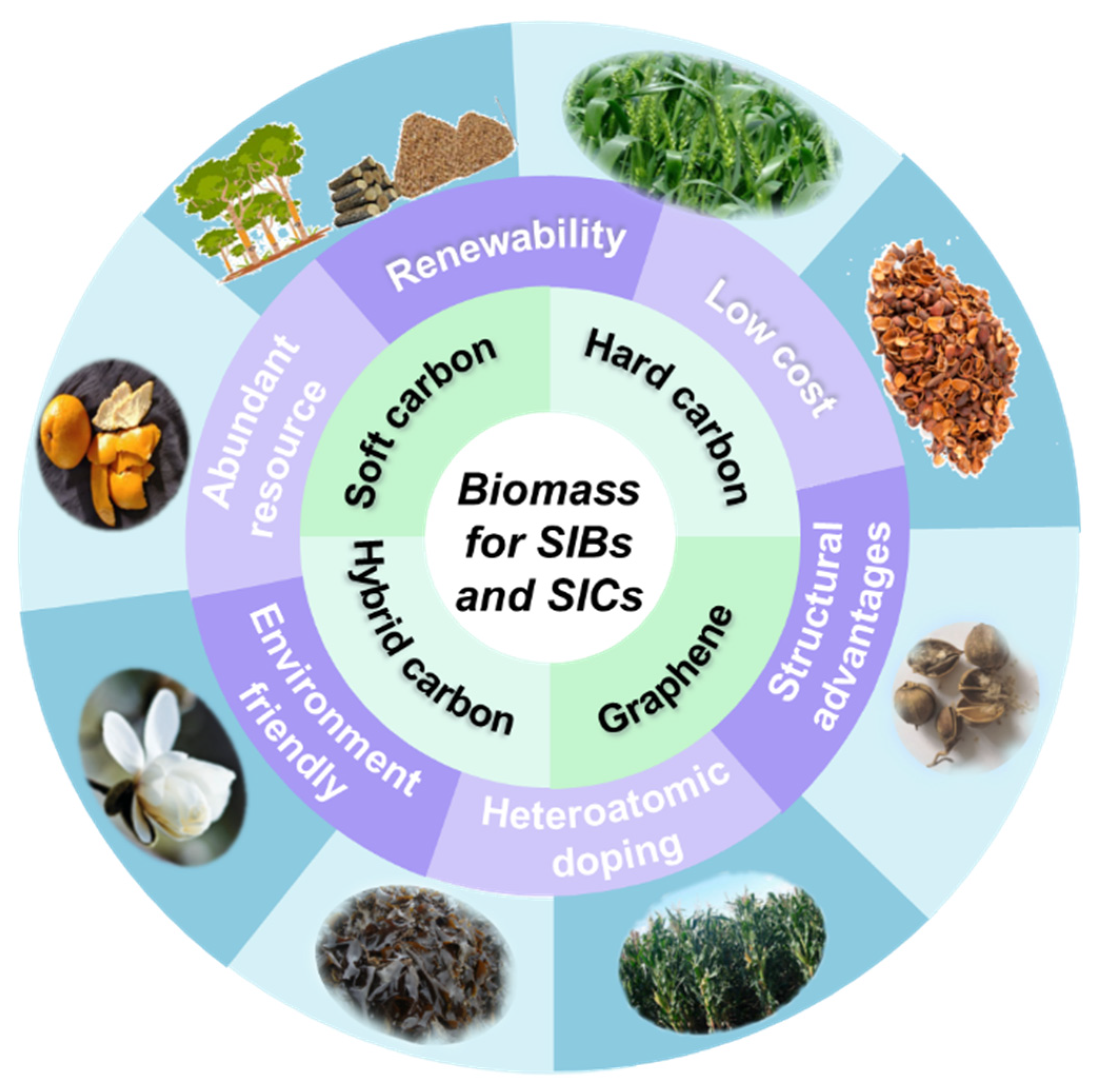
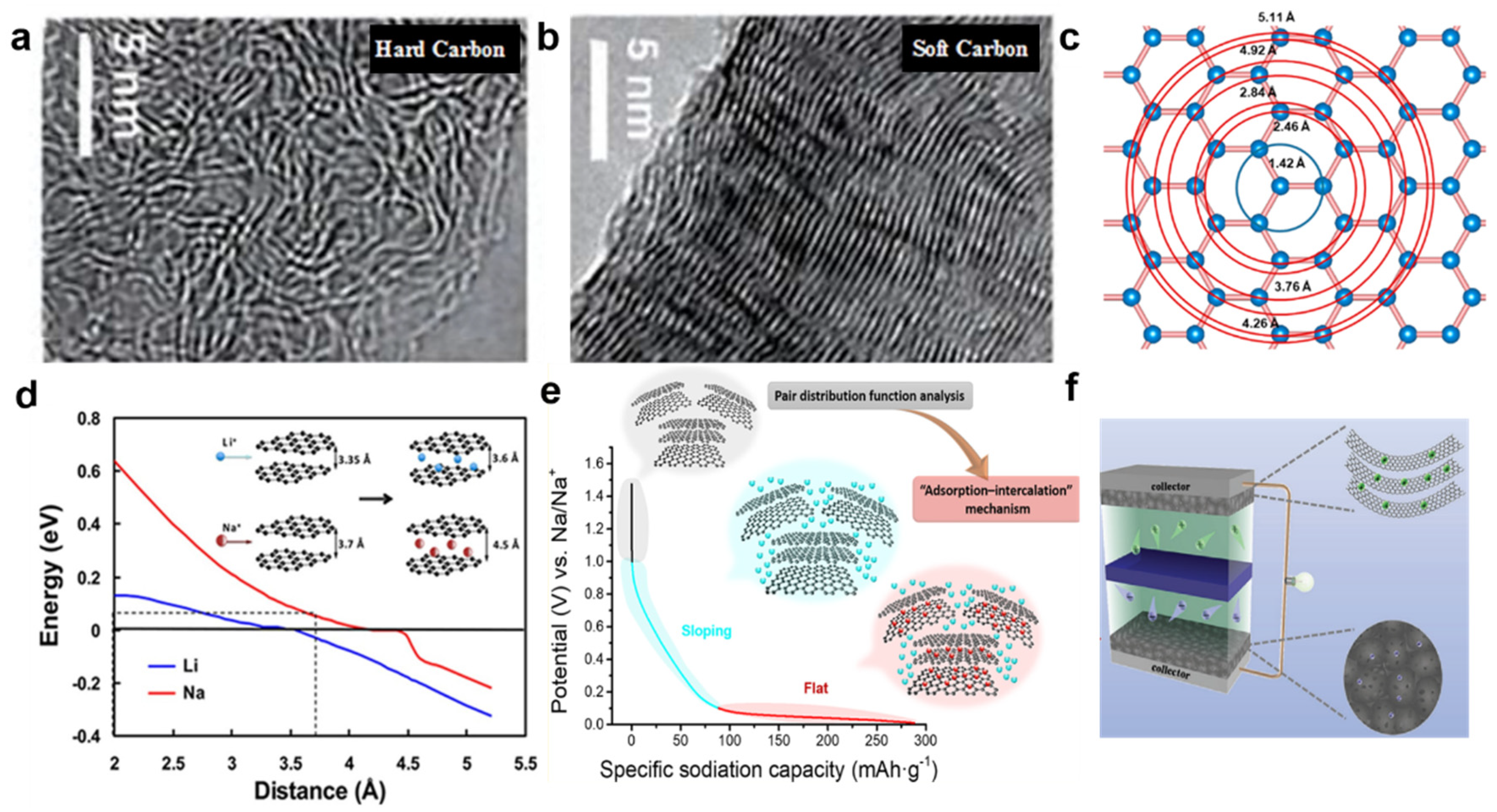
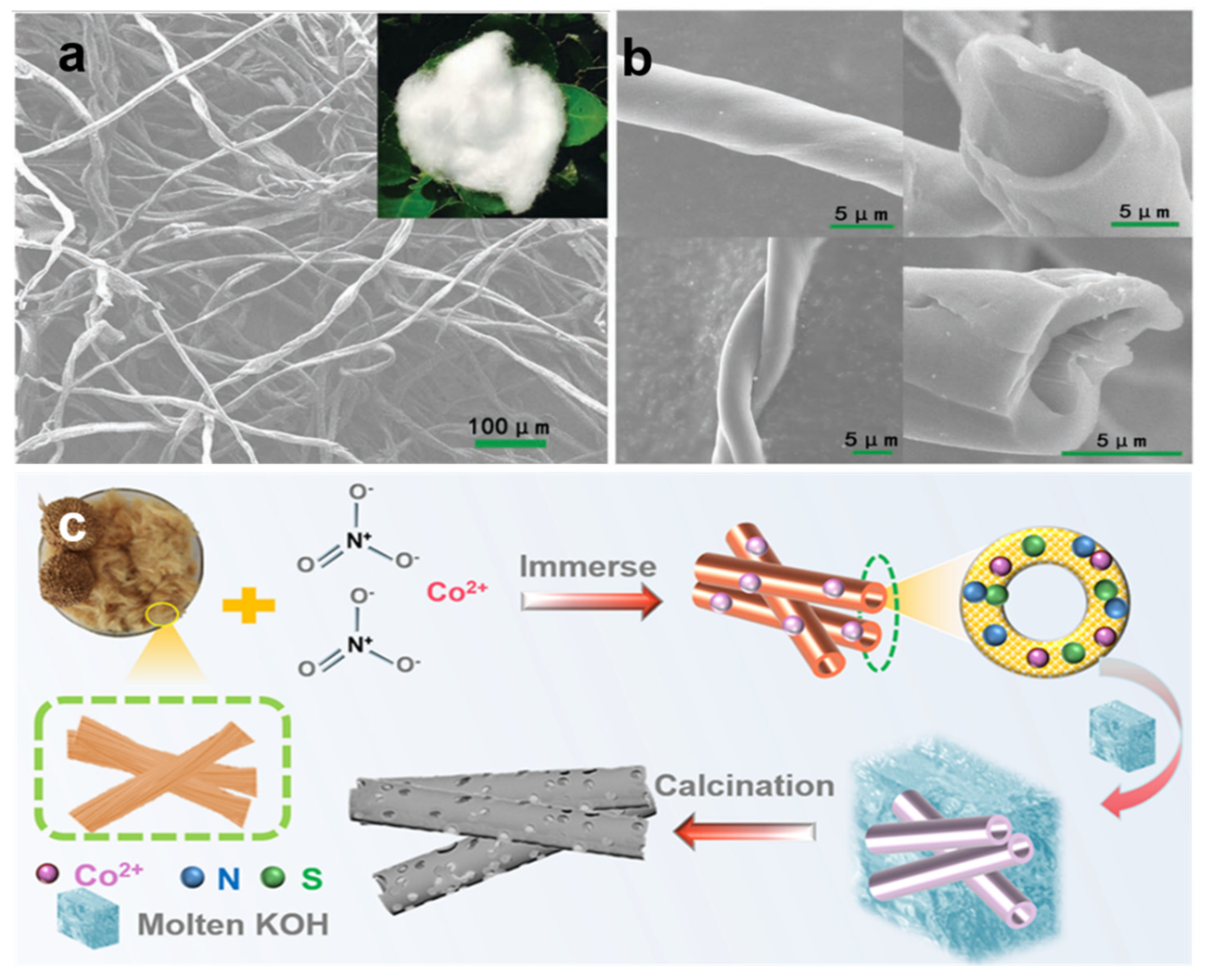
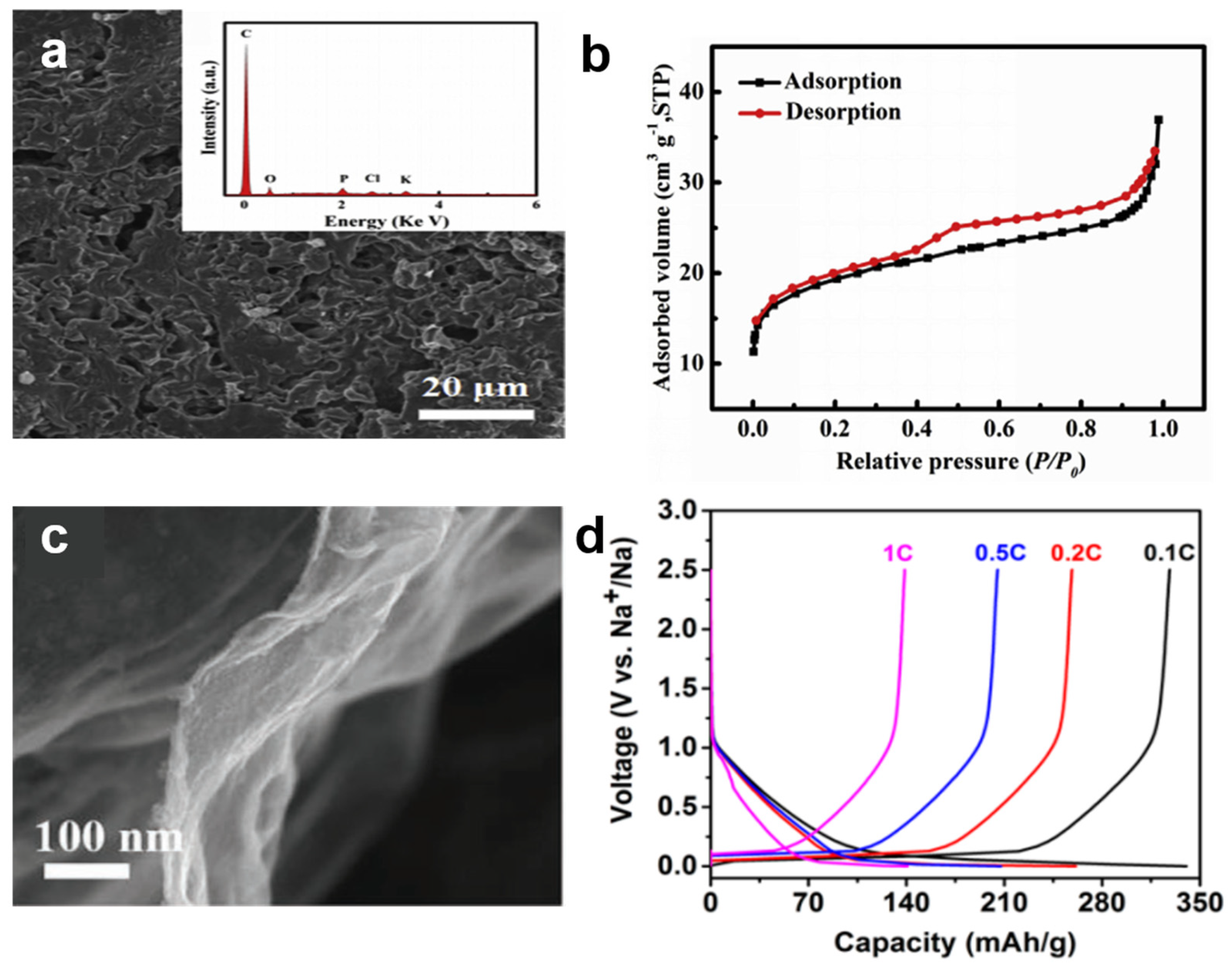
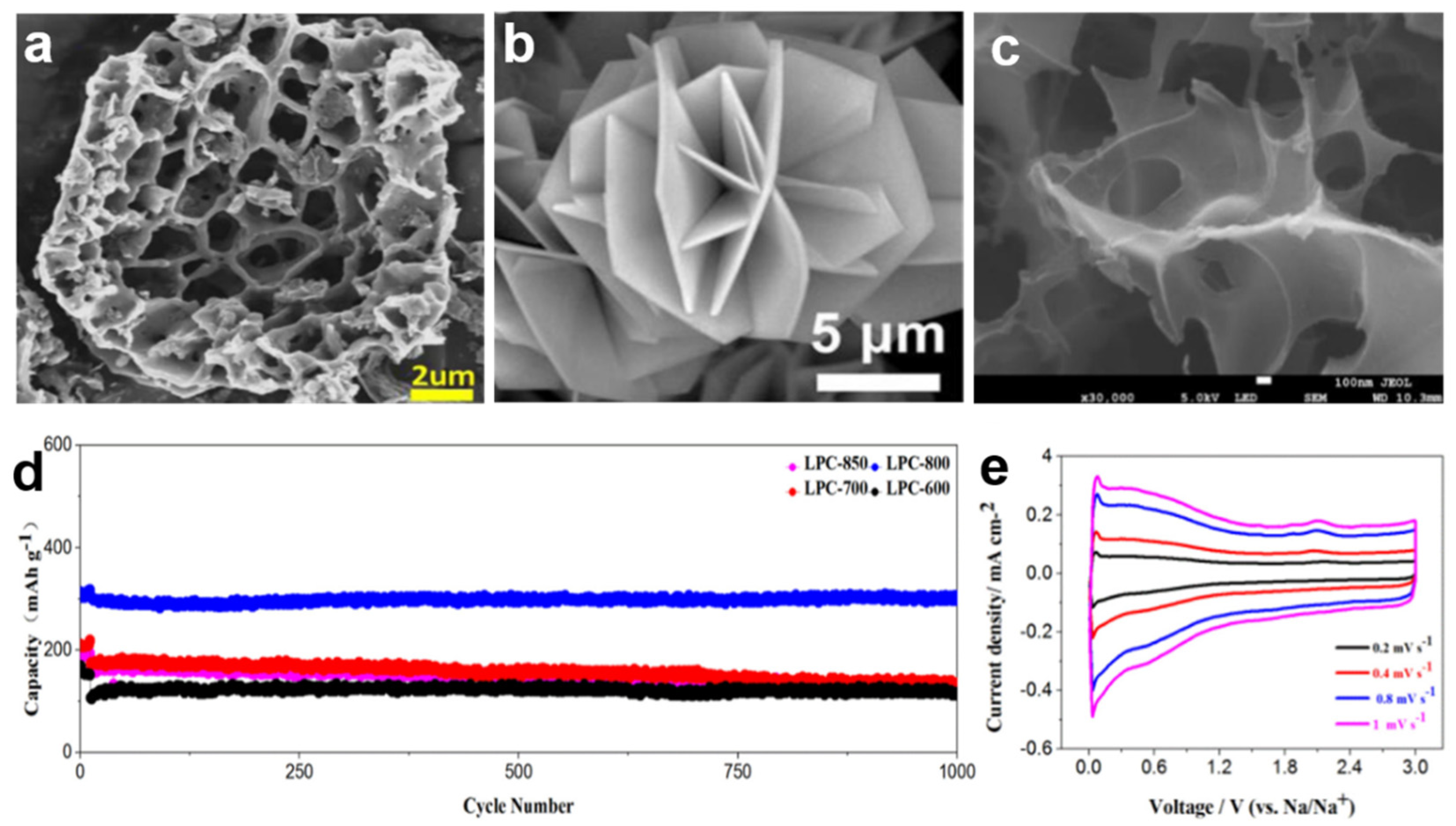
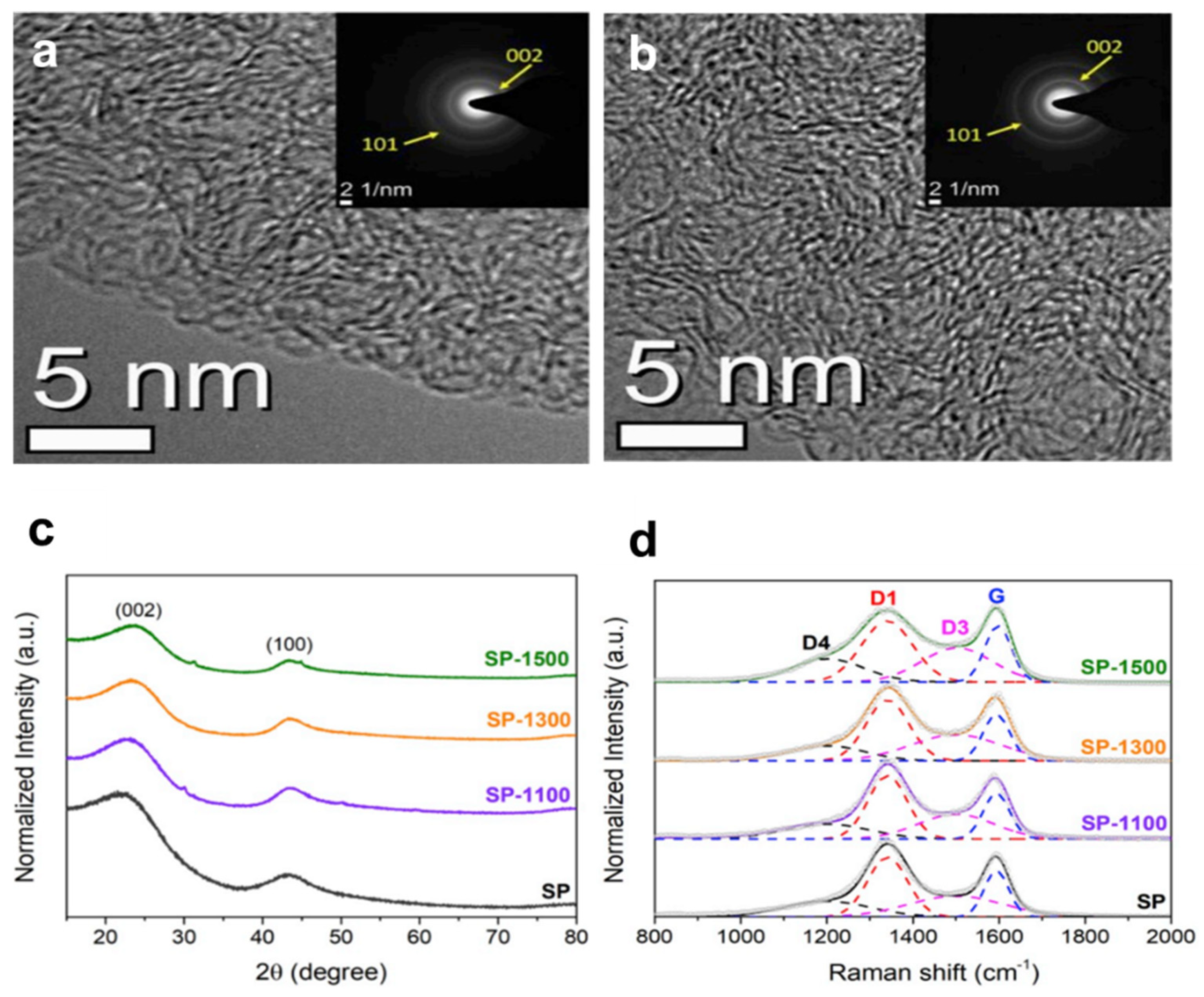

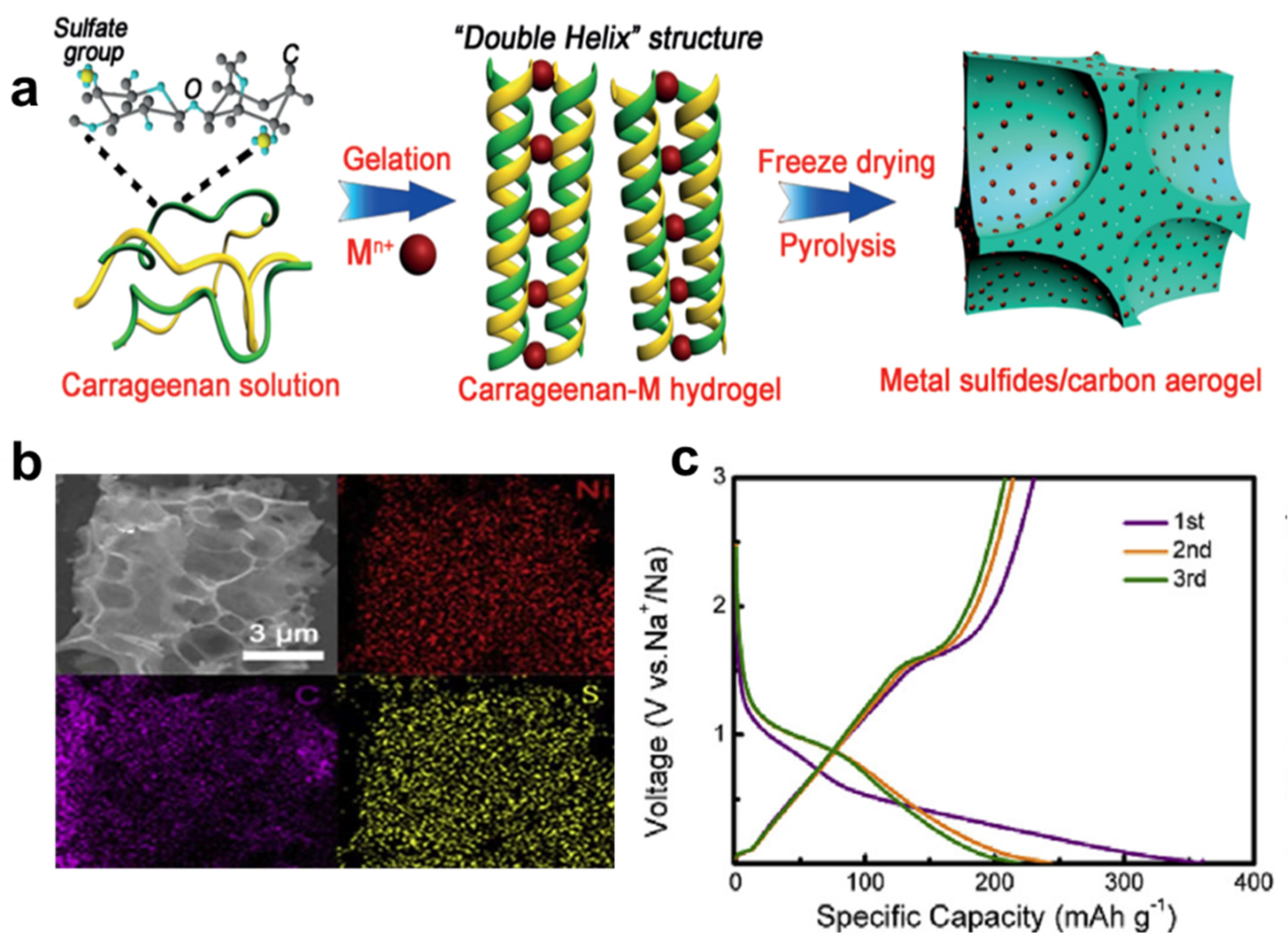
| Classification | Precursor | Yield [%] | Morphology | Application | Capacity [mAh g−1] /Current density [mA g−1] | ICE [a] [%] | Refs. |
|---|---|---|---|---|---|---|---|
| Graphite | / | / | sheets | SIB | 284/20 | 49.53 | [36] |
| / | / | spherical | SIC | 221 [b]/500 | / | [37] | |
| Graphene | Graphite | / | sponges | SIB | 372.0/50 | 67.4 | [38] |
| Graphite | / | nanosheets | SIB | 240/200 | 52 | [39] | |
| Cellulose/chitosan/GO | / | Layers | SIB | 395/100 | / | [40] | |
| Graphite | / | folded texture | SIC | 115.6/100 | / | [41] | |
| Graphite | / | porous | SIC | 420/100 | / | [42] | |
| Soft carbon | Coal | / | porous | SIB | 267/500 | 34.0 | [43] |
| Pitch | 70 | porous | SIB | 268.3/100 | 82 | [44] | |
| Hard Carbon | Kapok | <10 | tube | SIB | 290/30 | 80 | [45] |
| Cucumber stems | / | porous | SIB | 337.9/50 | 64.9 | [46] | |
| Cherry petals | / | nanosheets | SIB | 310/20 | 67.3 | [47] | |
| Pine pollen | / | porous | SIB | 370/100 | 59.8 | [48] | |
| Longan shell | / | porous | SIB | 345/100 | 73 | [49] | |
| Leonardite humic acid | 60.73 | flakes | SIB | 345/100 | 73 | [50] | |
| gelatin | / | nanosheets | SIB | 309/200 | 84.1 | [51] | |
| Mushroom stalk | / | porous | SIB | 305/100 | 33.8 | [5] | |
| Samara | / | porous | SIB | 333.2/100 | 35.7 | [52] | |
| Chlorella | / | nanoparticle | SIB | 436/100 | 51 | [53] | |
| Carrageenan | / | double-helix | SIB | 380/100 | 56.3 | [54] | |
| Enteromorpha | / | sponge | SIC | 362/100 | / | [55] | |
| Carboxymethyl cellulose | / | porous | SIC | 322/50 | / | [56] |
Publisher’s Note: MDPI stays neutral with regard to jurisdictional claims in published maps and institutional affiliations. |
© 2022 by the authors. Licensee MDPI, Basel, Switzerland. This article is an open access article distributed under the terms and conditions of the Creative Commons Attribution (CC BY) license (https://creativecommons.org/licenses/by/4.0/).
Share and Cite
Yan, M.; Qin, Y.; Wang, L.; Song, M.; Han, D.; Jin, Q.; Zhao, S.; Zhao, M.; Li, Z.; Wang, X.; et al. Recent Advances in Biomass-Derived Carbon Materials for Sodium-Ion Energy Storage Devices. Nanomaterials 2022, 12, 930. https://doi.org/10.3390/nano12060930
Yan M, Qin Y, Wang L, Song M, Han D, Jin Q, Zhao S, Zhao M, Li Z, Wang X, et al. Recent Advances in Biomass-Derived Carbon Materials for Sodium-Ion Energy Storage Devices. Nanomaterials. 2022; 12(6):930. https://doi.org/10.3390/nano12060930
Chicago/Turabian StyleYan, Mengdan, Yuchen Qin, Lixia Wang, Meirong Song, Dandan Han, Qiu Jin, Shiju Zhao, Miaomiao Zhao, Zhou Li, Xinyang Wang, and et al. 2022. "Recent Advances in Biomass-Derived Carbon Materials for Sodium-Ion Energy Storage Devices" Nanomaterials 12, no. 6: 930. https://doi.org/10.3390/nano12060930
APA StyleYan, M., Qin, Y., Wang, L., Song, M., Han, D., Jin, Q., Zhao, S., Zhao, M., Li, Z., Wang, X., Meng, L., & Wang, X. (2022). Recent Advances in Biomass-Derived Carbon Materials for Sodium-Ion Energy Storage Devices. Nanomaterials, 12(6), 930. https://doi.org/10.3390/nano12060930







